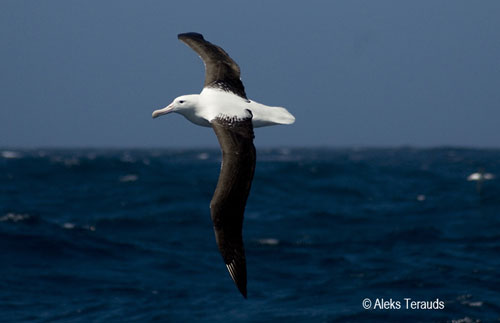A one-day workshop to assess potential research priorities for New Zealand breeding albatrosses and petrels was held at the National Museum of New Zealand - Te Papa Tongarewa on 11 August 2012, the day before the Fifth International Albatross and Petrel Conference commenced. The co-facilitators of the workshop were John Croxall (Global Seabird Programme, BirdLife International) and Kerry-Jayne Wilson (West Coast Blue Penguin Trust). The following report of the workshop presents some provisional findings which may be subject to change once the draft report is commented on by the workshop participants.
Most New Zealand petrels, and indeed many of the most threatened species, are not listed within the Albatross and Petrel Agreement, thus only a small part of the time available for the workshop was devoted to the ACAP species. Of the New Zealand breeding ACAP-listed species those with the greatest need for research are Salvin's Albatross Thalassarche salvini on the Bounty Islands and White-chinned Petrels Procellaria aequinoctialis, for which there has been very little research conducted within the New Zealand region. The Chatham Island populations of Northern Royal Diomedea sanfordi and Buller's T. bulleri Albatrosses also require research and monitoring.

Northern Royal Albatross: a New Zealand breeding endemic
Photograph by Aleks Terauds
A number of taxonomic matters was raised, concerning identifying potentially cryptic species of Little Shearwaters Puffinus assimilis, storm petrels and diving petrels, amongst others. Of greatest concern were the status of the Kermadec subspecies of the White-faced Storm Petrel Pelagodroma marina albiclunis and the Codfish Island population of the South Georgian Diving Petrel Pelecanoides georgicus. If, as preliminary studies suggest, these comprise distinct taxa they would be two of the World's rarest procellariiforms.
For other non-ACAP-listed species it was much harder to recommend specific priorities as, with the exception of some of the most Critically Endangered species, little is known of the distribution, population status or trends for most burrow-breeding petrels in New Zealand. Seabird surveys are underway on islands along the north-eastern coast of the North Island but few other island surveys have been undertaken during the last 20 years. For seabirds, Fiordland, the Ruapuke Islands and the islands off the east coast of Stewart Island remain the least known.
The eradication of introduced mammals from islands has presumably greatly benefited petrels but there have been few pre- and post-eradication surveys to document benefits to seabirds. A list of islands where mammal eradication is desirable was drawn up with Pitt Island, Chatham Island group (feral cats and pigs, Weka Gallirallus australis and House Mice) and Auckland Island (feral pigs and cats) heading the list.
The new generation of geolocators has now been deployed on a number of the smaller petrels in New Zealand, in particular some of the Pterodroma gadfly species, providing entirely new insights into the distribution and ecology of these birds. For some species we now know more of their behaviour at sea than on land.
A full report on the outcomes of the workshop will be available in due course. We thank the 25 participants for their input, the Australasian Seabird Group and the National Museum of New Zealand - Te Papa Tongarewa for sponsoring the workshop, and Nicholas Carlile for taking the minutes.
Kerry-Jayne Wilson, West Coast Blue Penguin Trust, 12 September 2012

 English
English  Français
Français  Español
Español